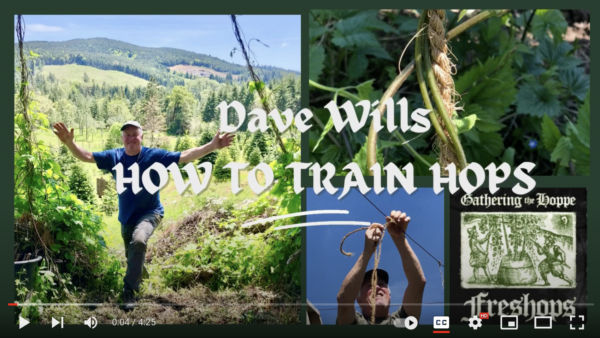It’s late Spring, you’ve planted your hops rhizomes in your beer garden, and now the plants are starting to grow! Once they reach about 2’ high, it’s a good time to start training the bines to grow vertically to help you optimize your hop yields. Get your stakes, twine, and hammer ready because in this video, Freshops owner Dave Wills shows you how to train hops.

Transcript for “How to Train Hops” with additional notes
Today we’re going to demonstrate how to string up your hops and how to train your hops. I use this large tripod ladder. I’ve got some of my hop twine. Here we go!
Note: I already have the overhead trellis’ to attach the twine. If you don’t, you’ll want to create them around 9’ – 16’ above your hop hills. Freshops sells hop twine bines love!
You don’t have to have any kind of special knot. Basically, any knot that will hold it up here. Ok, the strings are up!
Next, put your stake in the ground
Now, the easiest way to do this is by driving a stake into the ground – here. I’ve got this wooden stake which I’ve put these little notches here [near the top] in order to hold the twine to the stake. The stakes can stay in the ground all year round. But I want to show you what I use.
Then Attach The Twine
Make sure you have equal tension. Wrap the twin on there. Plenty of rope here, plenty of string twine. My trellis isn’t as tall as some trellis’ so I’ll be able to cut that [extra rope] off. So now, we have our string ready to go! We got our beautiful hops all ready to go.
How to Train Your Hop Bines
The sun goes across the sky from the East to the West, so these bines will also want to do that. As you look at the ground, that’s the same thing as clockwise. I’m going to grab a handful of bines here. And get them up on the string, and give them a little twist on the string, clockwise.
Note: The reason to make sure you twist them clockwise is that it’s in bines nature to grow clockwise. If you twist them counter-clockwise, they will fail to climb up.
Select the Bines and Get Wrapping
Here’s one. This one’s too far away. We’ll be putting strings down the line to get to the other ones. Here’s a good one right here. I like to do two or three bines per string. Just wrap them on there! And they’ll stay on there. These bines are not super long, but you get the idea. There you go! They are trained! And now they’ll start wrapping around here, and you don’t really have to do anything.
Hop 2 It!
Just add some water and keep the weeds down, and you’ll be Hopping 2 it!
Helpful Products
Freshops Hop Twine (Coir Yarn)
Dave recommends and uses this hop twine because the hop bines have a good surface to grab and grow on. Made from the coir fiber of the coconut husk and imported from Sri Lanka. Commercial Growers have been using Coir Yarn for years. A bundle of coir is 10- 20 ft. strings. Tested to 85 lbs.
In addition to agricultural twine, coir yarn is used in the manufacture of mats/matting and carpets, brush mats/matting, netting, geotextiles (for landscaping and on embankments of road construction to prevent soil erosion), and building construction.
Dave uses his own homemade stakes – simple wood with notches carved. However, if you would like western red cedar stakes that are laser engraved with the hop variety you are planting, then here you go!
For information on how to insert hop twine without using a stake, check out How to Train Hops, Part 2 video